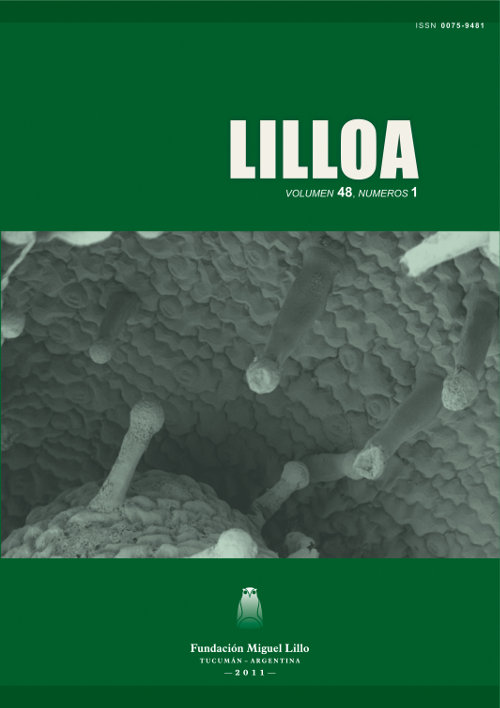Riparian forests and cattle management problems in Andean subtropical streams: in the search of water quality sustainability
Palavras-chave:
Riverine quality indices, Introduced species, Land uses, Intermountain valleys, South AmericaResumo
Quiroga, P. A.; H. R. Fernández; M. D. Sirombra; E. Domínguez. 2011. “Riparian forests and cattle management problems in Andean subtropical streams: in the search of water quality sustainability”. Lilloa 48 (1). Subtropical Andes harbor the headwaters of three huge South American basins (Plata, Salí-Dulce and part of the Amazon). They are affected by numerous different human activities, many of them too complex to approach from punctual perspectives. It has been suggested that domestic cattle activities result in a set of direct and indirect impacts. Riverine landscapes in Andean subtropics are affected by the type of cattle management used. Here we present the observed changes in a river and its surrounding area, from a basin studied for ten years. We concluded that cows can be considered as landscape engineers of the riparian zone. The QBR-MR (a modification of the European River Quality Index) is proposed, to include the cattle impact on Mountain Riparian forests. A detailed station by station description of the Riparian forest (percentage of exotic/native species and visual evaluation of different cattle impacts) and biological index based water quality are presented. The information is summarized in a map, easily accessible by policy designers. Combined quality indices for water and riparian areas are promissory tools to identify problems and biomonitoring in subtropical basins.
Downloads
Referências
Aide T. M. and Grau H. R. 2004. Globalization, migration and Latin American ecosystems. Science, 305: 1915-1916.
Braioni, A., Braioni, M. G., Franceschi, P. De, Mason, F., Ruffo, S. et Sambugar, B. 1994. Indici Ambientali sintetici di valutazione della qualitá delle Rive. Ambiente Risorse Salute, 23: 45-52.
De Pietri, D. E. 1992. The search for ecological indicators: is it possible to biomointor forest system degradation caused by cattle ranching activities in Argentina? Vegetatio, 101: 109-121.
Falkenmark M. and Folke C. 2000. How to Bring Ecological Services into Integrated Water Resources Management. Ambio, 29: 351-352.
Fernández H. R. and Molineri C. 2006. Toward a Sustainable Experience in an Intermountain Valley in Northwestern Argentina. Ambio, 35: 262-266.
Fernández H. R., Romero, F. and Dominguez E. 2009. Intermountain basins use in Subtropical Regions and their influences on benthic fauna. River Research and Applications, 25: 181-193.
Grau A. and Brown A. D. 2000. Development Threats to Biodiversity and Opportunities for Conservation in the Mountain Ranges of the Upper Bermejo River Basin, NW Argentina and SW Bolivia. Ambio, 29: 445-450.
Grau, H. R. and Aide T. M. 2007. Are Rural–Urban Migration and Sustainable Development Compatible in mountain Systems? Mountain Research and Development, 27: 119-123.
Grau H. R., Hernández M. E., Gutierrez J., Gasparri N. I., Casavecchia, M. C., Flores-Ivaldi E. E. and Paolini L. 2008. A Peri-Urban Neotropical Forest Transition and its Consequences for Environmental Services. Ecology and Society, 13: 35.
Harper D. M. and Pacini N. 2008. Aquatic and semiaquatic vertebrates. In: Dudgeon D (ed.) Aquatic Ecosystems: Tropical Stream Ecology. Elsevier, San Diego: pp. 147-197.
Herrero M. A. and Gil S. B. 2008. Environmental considerations of the animal production intensification. Ecología Austral, 18:273-289.
Izquierdo A. E. and Grau H. R. 2009. Agriculture adjustment, land-use transition and protected areas in Northwestern Argentina. Journal of Environment Management, 90 (2): 858-865.
Karaus, O. 2004. The Ecology of Lateral Aquatic Habitats along River Corridors. PhD Thesis. Diss ETH No. 15841. Zürich, Swiss.
Kutschker, A.; Brand C. and Miserendino M.L. 2009. Evaluación de la calidad de los bosques de ribera en ríos del NO del Chubut sometidos a distintos usos de la tierra. Ecología Austral, 19: 19-34.
Marty, J. T. 2005. Effects of Cattle grazing on Diversity of Ephemeral Wetlands. Conservation Biology, 19: 1626-1632.
Moog O. and Chovanec A. 2000. Assessing the ecological integrity of rivers: walking the line among ecological, political and administrative interests. Hydrobiologia, 422/423: 99-109.
Moyano M. Y. and Movia C. P. 1988. Relevamiento fisonómico-estructural de la vegetación de las sierras de San Javier y el Periquillo (Tucumán-Argentina), I: Área de las Yungas. Lilloa, 37: 123-135.
Munné A., Prat N., Solà C., Bonada N., Rieradevall M. 2003. A simple field method for assessing the ecological quality of riparian habitat in rivers and streams: QBR index. Aquatic and Conservation: Marine and Freshwater Ecosystems, 13: 147-163.
Naiman R. J., Décamps H. and McClain M. E. 2005. Riparia. Ecology, Conservation, and Management of Streamside Communities. The Netherlands: Elsevier Academic Press.
Saravia-Toledo, C. J. 1996. Impacto de la Ganadería en las Cuencas Hidrográficas del Noroeste Argentino. Anales de la Academia Nacional de Agronomía y Veterinaria, 50 (5): 13-32.
Vázquez D. P. 2002. Multiple effects of introduced mammalian herbivores in a temperate forest. Biological Invasions, 4: 175-191.
Walker B., Kinzing A. and Langridge J. 1999. Plants attribute diversity, resilience and ecosystem function: The nature and significance of dominant and minor species. Ecosystems, 2: 95-113.
Ward J.V., Malard F. and Tockner K. 2002. Landscape ecology: a framework for integrating pattern and process in river corridors. Landscape Ecology, 17 (Suppl. 1): 35-45.






